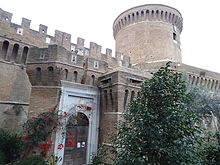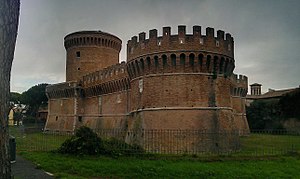|
Ostia Antica (district)
Ostia Antica is the 35th zona of Rome, Italy, four kilometers away from the coast. It is identified by the initials Z. XXXV and it is distinct from Ostia. Ostia Antica belongs to Municipio X. HistoryUnder the Romans, Ostia Antica reached a peak of some 75,000 inhabitants in the 2nd and 3rd centuries AD. The city became an episcopal see as part of the Diocesi of Rome as early as the 3rd century. St. Augustine passed through in the late 4th century; his mother, St. Monica, died here in 387 in a house property of the Diocesi of Rome. The cathedral (titulus) of Santa Aurea was later erected over her tomb. In 414 the poet Rutilius Namatianus reported a lack of maintenance of the city; it is traditionally thought that Ostia began a slow decline in the time of Constantine I, but data from recent excavations put the date of decline later. The city contained 26 operating baths in the 4th century and there is plenty of evidence of repairs on public buildings and the construction of new edifices. There was decay in some areas, but this late period was primarily one of transition; formerly filled with workers employed in collecting, storing and moving huge amounts of grain, oil, wine and other products to feed Rome, Ostia now assumed the character of a seaside resort. The city remained prosperous into the 5th century, as it was the seat of the Praefectus annonae. There was expansion beyond the western and southern walls in the area of the Porta Marina.[2]  As the centuries passed, Ostia fell into ruin but continued to provide maritime access for visitors to Rome. Saracen pirates were a frequent concern; the naval Battle of Ostia was fought off the coast in 849. Pope Gregory IV fortified the existing borough and it was rechristened Gregoriopoli. By this time, the shifting course of the Tiber had landlocked the ancient port, and the town was mainly a shelter for the workers of the nearby salt mills. In the late 15th century, the bishop Giuliano della Rovere (later Pope Julius II) commissioned the rebuilding of the main church and town walls under the direction of the architect Baccio Pontelli. The Castle of Julius II, also built at this time, remains the most striking feature of modern Ostia. The castle was abandoned after a flood in 1587 inundated its moat and turned the surrounding area into a marsh. The castle and the town were restored again in the 20th century. GeographyOstia Antica is located in the south-western part of the municipality of Rome, separated from the urban complex, along the river Tiber. The territory of Ostia Antica includes the major part of the urban zone 13E Ostia Antica. BoundariesOstia Antica borders to the north with the municipality of Fiumicino, from which is separated by the stretch of the river Tiber between Ponte di Tor Boacciana and the Canale dei Pescatori. The zone borders eastward with Zona Acilia Nord (Z. XXXII), whose boundary is marked by the Canale dei Pescatori, up to Via del Mare. To the south-east, Ostia Antica borders with Zona Casal Palocco (Z. XXXIV), whose border is marked by the stretch of Via del Mare between Via della Macchiarella and Via di Tor Boacciana. To the south-west, the zone borders with Quartiere Lido di Ostia Ponente (Q. XXXIV), from which is separated by Via di Tor Boacciana, up to the river Tiber. Historical subdivisionBeside the frazione of the same name, which also includes the ancient borough, the territory of Ostia Antica includes the urban areas of Saline di Ostia and Bagnoletto. OdonymyWhile in the ancient village of Ostia road and squares are mainly named after places and people related to the ancient local history, odonyms of the surrounding area all refers to archaeologists and historians. Few streets near the border with Acilia Nord are named after towns of Veneto and Lombardia. Odonyms of the zone can be categorized as follows:
Places of interest  Civil buildings
Archaeological sitesReligious buildings
Natural areas
In popular culture
Bibliography
External linksReferences
|
||||||||||||||||||||||||||||||||
Portal di Ensiklopedia Dunia

